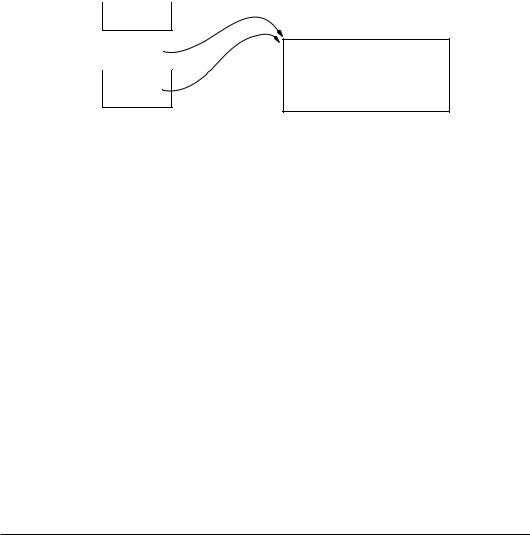
- •Preface
- •DESIGN FEATURES
- •STRUCTURED PROGRAMMING TECHNIQUES
- •PROGRAMMING TASKS
- •WINDOW SYSTEMS, COMMUNICATIONS, AND DISPLAYS
- •DATA STRUCTURES AND ALGORITHMS
- •CONCLUDING THOUGHTS
- •PostScript is Not Like C
- •COMPARISON OF LANGUAGE MECHANISMS
- •EXPRESSING AN ALGORITHM AS A PROGRAM
- •THE UNIX SHELL AND OPERATING SYSTEM
- •INPUT, OUTPUT, AND THROUGHPUT
- •CONCLUDING THOUGHTS
- •Foundations
- •POSTSCRIPT LANGUAGE SYNTAX
- •SIMPLE PROGRAM STRUCTURE
- •Make Definitions First
- •Indentation Style
- •SETTING UP TEMPLATES
- •DECLARING AND USING VARIABLES
- •Arithmetic with Numeric Variables
- •Using the // Notation for Constants
- •ALLOCATING MEMORY
- •GETTING MEMORY BACK
- •OPENING AND CLOSING FILES
- •COMPARISONS AND EQUALITY OF OBJECTS
- •CONCLUDING THOUGHTS
- •Some Typical Programs
- •A TYPICAL PAGE DESCRIPTION PROGRAM
- •FONT PROGRAMS
- •PROGRAMS THAT READ DATA
- •QUERY PROGRAMS
- •ENCAPSULATED POSTSCRIPT PROGRAMS
- •PERSISTENTLY RESIDENT PROGRAMS
- •CONCLUDING THOUGHTS
- •Understanding the Stack
- •A QUICK OVERVIEW OF DATA TYPES
- •NAME LOOKUP
- •HOW OPERATORS USE THE STACK
- •GROUPING AND VISUAL CHUNKING
- •THINKING BACKWARD AND SIDEWAYS
- •COMPOSITE OBJECTS
- •THE OTHER STACKS
- •The Dictionary Stack
- •The Execution Stack
- •The Graphics State Stack
- •CONCLUDING THOUGHTS
- •Trusting the Stack
- •SAFETY OF DATA ON THE STACK
- •WHERE ARE THE DATA GOING?
- •REARRANGING THE STACK
- •Using the dup and index Operators
- •Using the roll Operator
- •CONDITIONALS AND LOOPS
- •RECURSION AND LOCAL VARIABLES
- •CONCLUDING THOUGHTS
- •Building Conditional Statements
- •SIMPLE CONDITIONALS
- •SETTING UP THE CONDITION
- •CONDITIONALS ARE NOT MAGIC
- •NESTED CONDITIONALS AND ELSE CLAUSES
- •COMPOUND CONDITIONALS
- •CONCLUDING THOUGHTS
- •Using Looping Constructs
- •LOOP BASICS
- •USING THE LOOP INDEX
- •LOOPS ARE PROCEDURE BODIES
- •LOOPS OF INSTRUCTIONS
- •EXITING LOOPS PREMATURELY
- •CONCLUDING THOUGHTS
- •Procedures
- •WHAT EXACTLY IS A PROCEDURE?
- •PARAMETER PASSING
- •CONSTRUCTING GOOD PROCEDURES
- •What to Name Your Procedure
- •A Useful Naming Convention
- •SELF-MODIFYING PROCEDURES
- •CONCLUDING THOUGHTS
- •Using Dictionaries
- •DICTIONARIES FOR NAME SCOPING
- •LOCAL DICTIONARIES
- •GLOBAL DICTIONARIES OF PROCEDURES
- •MAINTAINING THE DICTIONARY STACK
- •INTO AND OUT OF DICTIONARIES
- •LOOKING INTO DICTIONARIES
- •Using the forall Operator
- •Using the where and known Operators
- •REDEFINING OPERATORS
- •Changing the Behavior of Operators
- •Debugging with Redefined Names
- •Proper Nesting of Redefinitions
- •CONCLUDING THOUGHTS
- •Creating and Manipulating Data
- •CONSTRUCTING AN ARRAY
- •CONSTRUCTING A STRING
- •MANIPULATING DATA WITH PUT AND GET
- •CONCATENATING ARRAYS AND STRINGS
- •INPUT AND OUTPUT OF STRING DATA
- •ARRAYS VERSUS DICTIONARIES
- •ADVANCED TECHNIQUES
- •CONCLUDING THOUGHTS
- •Storing and Using Data
- •Data and the Operand Stack
- •Data and Algorithms for Underlining
- •CLASSICAL DATA STRUCTURES
- •Linked Lists
- •Using Arrays to Form Lists
- •Using Dictionaries to Form Lists
- •Queues, Trees, and Other Data Structures
- •CONCLUDING THOUGHTS
- •Program Data and Instructions
- •TURNING DATA INTO INSTRUCTIONS
- •TURNING INSTRUCTIONS INTO DATA
- •DATA CONVERSIONS
- •CONCLUDING THOUGHTS
- •File Objects
- •Streams and Files
- •PostScript File Operators
- •OPENING AND CLOSING FILES
- •READING AND WRITING FILES
- •Reading from a File
- •Writing to a File
- •Copying and Renaming Files
- •WRITING FORMATTED DATA TO FILES
- •Writing Out Various Data Types
- •Spaces, Tabs, Returns, and Special Characters
- •FILE STATUS INFORMATION
- •RANDOM VERSUS SEQUENTIAL ACCESS
- •CONCLUDING THOUGHTS
- •Appendix
- •Answers to Exercises

The illustration in Figure 5.6 gives you an idea of what happens when you duplicate a composite object like a string. All stack manipulations to composite objects operate on the single object, not on the entire body of the composite data. In this example there are two string pointers on the operand stack that have the same value. If one of these is changed, they are both changed, as can be seen in Figure 5.6.
Figure 5.7: Changing a Composite Object
(PostScript) dup
dup 0 (Pre-) putinterval
somewhere in memory
string object
Pre-Script
length: 10
string object
length: 10
THE OTHER STACKS
There are three other stacks used by the interpreter during the execution of your program in addition to the operand stack, which you have been studying: the dictionary stack, which helps with name lookup and in making definitions; the execution stack, which holds partially executed procedure bodies, file objects, and other executable objects; and the graphics state stack, which keeps track of your gsave and grestore operations.
These stacks will be described briefly so that you’ll know about them. For more detailed information, refer to the books PostScript Language Reference Manual and PostScript Language Program Design, both by Adobe Systems, available from Addison-Wesley Publishing Company.
62 |
Chapter 5: UNDERSTANDING THE STACK |
